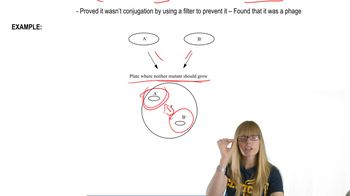5. Genetics of Bacteria and Viruses
Transduction
5. Genetics of Bacteria and Viruses
Transduction
Practice this topic
- Multiple Choice
True or False:Transduction uses viruses to transfer foreign DNA into bacteria
- Multiple Choice
Specialized transduction differs from generalized transduction because specialized transduction is defined by what?
- Multiple Choice
A cotransduction experiment was performed with two bacteria strains. The first train has the genotype l+ g m+ while the second strain has the genotype of l g+ m. The researchers found that 46 colonies had cotransduced m+ with l+, while only 25 colonies had cotransduced g with l+. Using this information determine which of the following gene pairs are closest together.
- Open QuestionIn this chapter, we have focused on genetic systems present in bacteria and on the viruses that use bacteria as hosts (bacteriophages). In particular, we discussed mechanisms by which bacteria and their phages undergo genetic recombination, which allows geneticists to map bacterial and bacteriophage chromosomes. In the process, we found many opportunities to consider how this information was acquired. From the explanations given in the chapter, what answers would you propose to the following questions?How do we know that bacteriophages recombine genetic material through transduction and that cell-to-cell contact is not essential for transduction to occur?
- Open QuestionHow is the frequency of cotransduction related to the relative positions of genes on a bacterial chromosome? Draw a map of three genes and describe the expected relationship of cotransduction frequencies to the map.
- Open QuestionA triple-auxotrophic strain of E. coli having the genotype phe⁻ met⁻ ara⁻ is used as a recipient strain in a transduction experiment. The strain is unable to synthesize its own phenylalanine or methionine, and it carries a mutation that leaves it unable to utilize the sugar arabinose for growth. The recipient is crossed to a prototrophic strain with the genotype phe⁺ met⁺ ara⁺. The table below shows the selected marker and gives cotransduction frequencies for the unselected markers.Selected Selected Colonies Containing the Marker Unselected Marker (%) _phe⁺ met⁺ ara⁺met⁺ 4 - 7phe⁺ - 2 51met⁺, phe⁺. - - 79ara⁺ 68 5 -Use the cotransduction data to determine the order of these genes.
- Open QuestionA triple-auxotrophic strain of E. coli having the genotype phe⁻ met⁻ ara⁻ is used as a recipient strain in a transduction experiment. The strain is unable to synthesize its own phenylalanine or methionine, and it carries a mutation that leaves it unable to utilize the sugar arabinose for growth. The recipient is crossed to a prototrophic strain with the genotype phe⁺ met⁺ ara⁺. The table below shows the selected marker and gives cotransduction frequencies for the unselected markers.Selected Selected Colonies Containing the Marker Unselected Marker (%) _phe⁺ met⁺ ara⁺met⁺ 4 - 7phe⁺ - 2 51met⁺, phe⁺. - - 79ara⁺ 68 5 -Identify the compounds present in each of the selective media.

